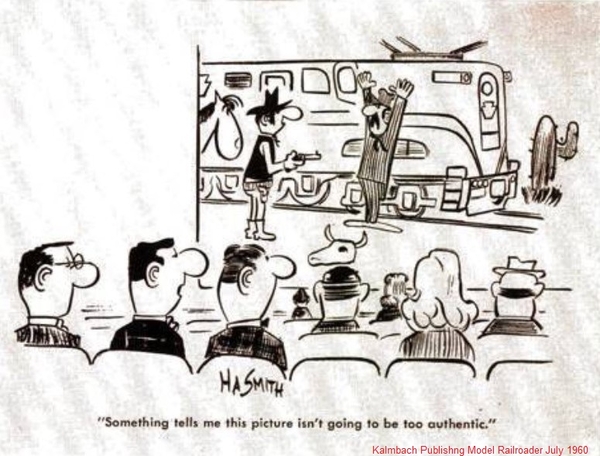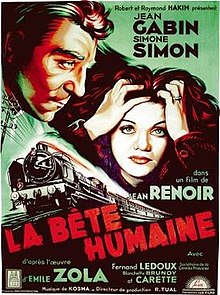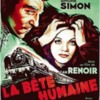Watched the TCM version yesterday after having seen the movie before and they botched the end by cutting it. The version shown went right to "The End" after yardmaster Carl Buckley strangled his wife Vicki in a Pullman compartment because she was trying to leave him. In the full version, the killer yardmaster is being chased through a train yard and in his panic steps out right in front of a mainline movement with the inevitable result. TCM's hacked version leaves the viewer wondering if justice was ever served or if the bad guy simply took off for parts unknown.
I started to watch that, Bill, but I was glad I didn’t. As a former film archivist, chopping up films like that is atrocious. TCM should know better. By the way, I thought you and Tom were coming up the road to see my G gauge layout last weekend!
Former Member posted:…In the last scene Glen Ford is at the controls of an Alco FA locomotive…Then we have a view out of the front window. No overhead wires and fairly open landscape…There are other mishaps earlier in the film such as Ford climbing into an Alco and getting out of a GM diesel…
Come on…
Do you really think the general public (the people who bought the tickets to pay for this film) knows the difference between an Alco and an EMD? Or whether a specific piece of railroad has overhead wires or not?
And on top of that, a general audience doesn’t care. They just want to be entertained.
@Bill Chaplik posted:Watched the TCM version yesterday after having seen the movie before and they botched the end by cutting it. The version shown went right to "The End" after yardmaster Carl Buckley strangled his wife Vicki in a Pullman compartment because she was trying to leave him. In the full version, the killer yardmaster is being chased through a train yard and in his panic steps out right in front of a mainline movement with the inevitable result. TCM's hacked version leaves the viewer wondering if justice was ever served or if the bad guy simply took off for parts unknown.
Hah! I thought I dreamed that sequence! I guess I'm not going crazy after all!
Jon ![]()
@Rich Melvin posted:Come on…
Do you really think the general public (the people who bought the tickets to pay for this film) knows the difference between an Alco and an EMD? Or whether a specific piece of railroad has overhead wires or not?
And on top of that, a general audience doesn’t care. They just want to be entertained.
Really. How many remember the Happy Days gang going from Milwaukee to California via the Pennsylvania behind a GG1...
Rusty
Attachments
@Bill Chaplik posted:Watched the TCM version yesterday after having seen the movie before and they botched the end by cutting it. The version shown went right to "The End" after yardmaster Carl Buckley strangled his wife Vicki in a Pullman compartment because she was trying to leave him. In the full version, the killer yardmaster is being chased through a train yard and in his panic steps out right in front of a mainline movement with the inevitable result. TCM's hacked version leaves the viewer wondering if justice was ever served or if the bad guy simply took off for parts unknown.
I am finding no references to an alternate ending (though I will admit to not having spent hours and hours looking). A review in the New York Times at the time of the movie's release would seem to match the ending that was on TCM. The AFI synopsis is what was shown on TCM the other night:
https://catalog.afi.com/Catalog/moviedetails/51233
The 1938 version by Jean Renoir, "La Bête Humaine," sounds like it has an ending closer to the one you describe.
David
FYI, the movie will be on Noir Alley on TCM late Saturday 9/18 (around midnight ET), and then again on Sunday morning. Dana Delany will also be on to discuss the movie with host Eddie Muller.
David
I've never seen Human Desire, but I understand it is loosely based on La Bete Humaine, which was made into a French movie that has fantastic scenes of French engine driving and railroad operations. You don't need to know French to enjoy the fabulous railroad footage in that film.
Attachments
LOL. Bing Crosby, Danny Kaye, Rosemary Clooney, and Vera Ellen took the Santa Fe and Southern Pacific from Florida to Vermont. Must have been the Looong Way. Then again as Rich said who would notice but us idiots.
In the old CSI: Crime Scene Investigation tv show, there's a scene where William Petersen's character is chasing a bad guy into a rail yard. An end cab switcher rolls by at about 10 MPH with one decrepit old coach behind it, and the bad guy jumps into the coach. I figure that wasn't a great place to hide, inside an empty car apparently being towed to a scrapyard. Petersen follows him - and it turns out the car is completely full of people! Apparently this was supposed to be a working Amtrak (or commuter?) train.
In the movie "Attack of the Fifty Foot Woman" our hero is driving a 1957 Plymouth two door station wagon. She picks it up and, when in her hands, it is a 1954 Chevrolet four door station wagon. When she throws it to the ground, it becomes a smashed 1957 Plymouth two door station wagon again.
In the movie "Killers Three" starring Dick Clark, the villain's car keeps switching back and forth between a 1939 Chevrolet and a 1940 Chevrolet. It also switches back and forth between a two door sedan and a four door sedan.
But who notices these things? ![]()
Where is Dan Thorn (Danger Lights) when you need him?
"You can't put the Olympian in the hole!"
It's too bad that there was a "railfan edit" DVD of Danger Lights that came out a while back that just showed the scenes with Milwaukee Road trains in them. From comments I've heard, I suspect a lot of people didn't realize they weren't seeing the entire movie and were complaining that the storyline was hard to follow. If you see the whole movie, it's actually pretty good - and was I think the first sound movie filmed 'on location'.
I will be uploading the full version of "Danger Lights" to my YouTube channel later today. The MAC is crunching the numbers on the video right now. I'll post here when it's ready for viewing.
You will love Dan Thorn. "You office guys! Hold up the Olympian? Tell 'er to come through! I'll clear the track!"
Hey Rich,
Glad to see that you are a Dan Thorn fan. This classic movie is one that every rail enthusiast should watch; very entertaining. My ten year old grandson borrowed my copy many years ago and watched it to many times he could say dialog like you just did. He didn't appreciate the love triangle, but the railroad scenes enthralled him.
That Dan Thorn is a good man, Mary.
As promised, here is "Danger Lights."
I've had this film in my library for many years. I just got around to publishing it on my YouTube channel.
It is a classic! You will love the gruff, old Superintendent, Dan Thorn.
"La Bête Humaine" will be on TCM early Monday morning, Nov. 14. In the TCM Imports segment. 2:45a ET.
David
I remember Human Desire. Broderick Crawford is the absolute best actor to play an iron-pants, brown suit, Trainmaster of the 1950's!
Thread still active after three years - not bad!
I was reminded watching something the other day that whenever the History Channel has a program where they need a shot of a US steam train, it's almost always some central-European train. A recent episode of "The Toys That Built America" had A.C. Gilbert going from New Haven CT to New York City in the early 1910s on a train with a black European steam engine with red wheels and a couple of obviously not American (let alone New Haven) passenger cars behind.
I have seen many train shows use online clip art to decorate their advertisements. Sometimes they use obviously European prototype trains instead of American ones. It really clashes.








